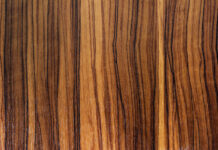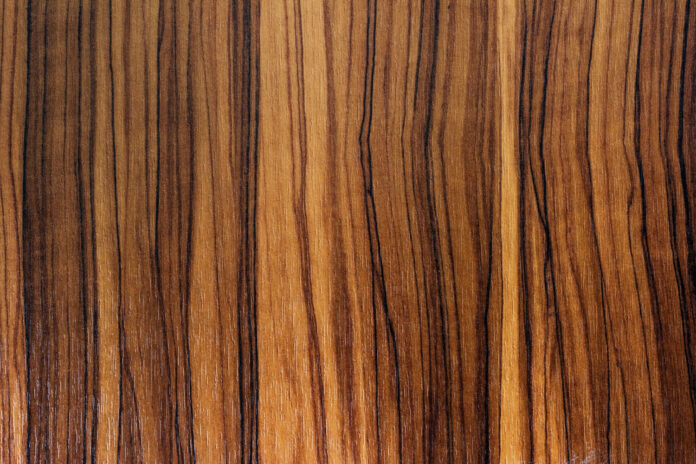Type of wood with a dark colour is referred to as “dark wood.” Because of their luxurious appearance, which raises the attraction of interior spaces, dark woods are more costly and in high demand.
You’re in the ideal place if you want to go with a dark wood type for your makeover. Each type of dark wood has unique characteristics and looks distinctive. Dark-coloured hardwoods are resilient, long-lasting, and suitable for a range of timber applications and interior design aesthetics.
Which Dark Wood Types Are the Best?
Learning about the characteristics of dark wood can help you choose the best kind for your project. There are many different types of dark wood. This section will discuss the common and unique species of dark wood.
1. A deep shade of black
Ebony, one of the dark wood types, is entirely black and has long, straight grain. Ebony is durable, strong, and resistant to termites and insects. It is more durable, has a smooth, fine texture, and is dense. Because of their extreme density, hand tools are challenging to operate.
Uses include, among other things, exquisite furniture and interior furnishings (musical instruments, cabinets, inlays, and decorations).
2. The walnut
Walnut is another popular kind of dark wood that is thick and dark brown. Walnut wood is found in the West Indies, America, Southern Europe, and Asia, among other places. Its grain is easy to work with, medium in density, medium in durability, and medium to coarse in texture. It is often straight and consistent.
Uses include veneers, flooring, furniture, interior design, and gunstocks.
3. The Teak
Hardwood Teak is strong and durable, having a light to dark golden brown hue. The majority of teak is grown in South Asia. possessing durability, high density, and resistance to decay and termites. Teak is characterised by its narrow, straight grain and a coarse, uneven feel. It’s just too good for machines.
Doors, flooring, window frames, furniture, boats, and both indoor and outdoor environments are some examples of applications.
4. Wenge
Wenge is another popular type of dark wood that is mostly found in Central Africa. Straight grain, gritty texture, medium-dark brown hue, and good solidity and durability are all characteristics of wenge.
It turned nearly black when oil finishes were applied. It is difficult to handle due to its density. able to tolerate termites effectively.
Musical instruments, tasteful furnishings, flooring, cabinets, and carved accents are among the uses.
5. Mahogany.
One of the most prevalent dark wood kinds is mahogany. South and Central America are the primary locations for its subtypes. Reddish-brown, stable, fine-grained, and extremely dense, strong, and long-lasting. Its qualities include excellent workability and reasonable pricing.
Furniture, cabinets, veneers, and both indoor and outdoor furniture are among the applications. Boats, musical instruments, and turned objects are also made with it.
6. Africa’s Blackwood
African blackwood is dark, almost black, and has a rich look. African blackwood is difficult to work with because of its even, fine texture, great density, and durability.
Applications include both indoor and outdoor environments, wall panels, unique furniture, and stylish flooring.
7. Ziricote
Ziricote is another type of dark wood that is primarily found in the Caribbean and Central America. Ziricote is characterised by its fine texture, interlocking grain, moderate workability, high density, and durability. It is medium-dark brown with black striations.
Features of Different Types of Dark Wood
The characteristics of dark woods are similar to those of most hardwoods:
- Sturdy, robust, and enduring.
- Range in colour from intense dark (black—ebony) to medium/dark brown/reddish-brown.
- All dark hardwoods have the same dark appearance.
- Dark wood varieties are generally seen as more aesthetically beautiful than lighter woods, regardless of whether they are unfinished or in their natural state.
- Whether or whether they are polished, these are often seen as more visually appealing than lighter woods. Their hardness usually makes them a little difficult to work with.
Tips for Space Styling with Dark Wood
Dark wood interiors may give any place a refined touch, even if there is no particular style. You can use those dark wood pieces to decorate your home with the help of these useful recommendations.
Mix and Match the Furniture Styles
Dark wood is quite versatile and can look very classic. Without hesitation, different furniture styles are contrasted and blended.
For example, use dark-wood cabinetry in a sleek, contemporary living space. It will add a subtle contrast and roughness to the entire design. In a colorful bohemian-style room, a dark
wood-framed bed might also be used to create a deeper contrast with lighter, softer-hued, and textured furnishings.
Highlights of the Cabinet
Dark wood isn’t limited to tables and chairs, as you may think.
Additionally, pick dark-wood cabinetry! All of it enhances the layout and use while creating a focal point in your kitchen, living room, or bedroom.
Decide on Durable Hardwoods
If you decide to buy dark wood furniture, think about getting a piece of hardwood that is strong, such as African blackwood or teak. This kind of wood is a wise investment for your house due to its longevity and capacity to tolerate deterioration for many years.
- Dark Wood Types: Benefits and Drawbacks
- Robust, long-lasting, uncommon, and costly.
- Termite, insect, and rot-resistant.
- Absorbing heat.
- Long-lasting natural appearance.
- Limits of the design.
- Gorgeous, exquisite, high-end furniture.
FAQs About Different Kinds of Dark Wood
Which type of wood is the most deeply colored?
Most likely, it would be ebony. This is one of the darkest forms of wood that can be found, and it is quite black.
How Is the Deep Colour of Dark Wood Maintained?
Due to wear and tear, dark-coloured things should be cleaned, polished, and even refinished to keep them looking brand new.
Because dark wood is more prone to scratches, extra caution is needed to prevent getting caught in the act.
Is Low-Cost Dark Wood Available?
The American black walnut is without a doubt among the least expensive dark woods on our list up here.
But bear in mind that the majority of dark wood types, especially African blackwood, purpleheart, and ebony, are highly costly.
For a darker finish, consider staining commonly available and reasonably priced wood types, such as oak, if you’re seeking for a less costly option to achieve dark wood.
How Do You Darken Light Woods?
Apply a premium stain or dye in thin, even layers to the grain to give light wood species like birch, oak, and pine that rich, dark wood look.
To protect your furniture and give it a posh, sophisticated look, use a clear finish that complements the hue you have selected.
























